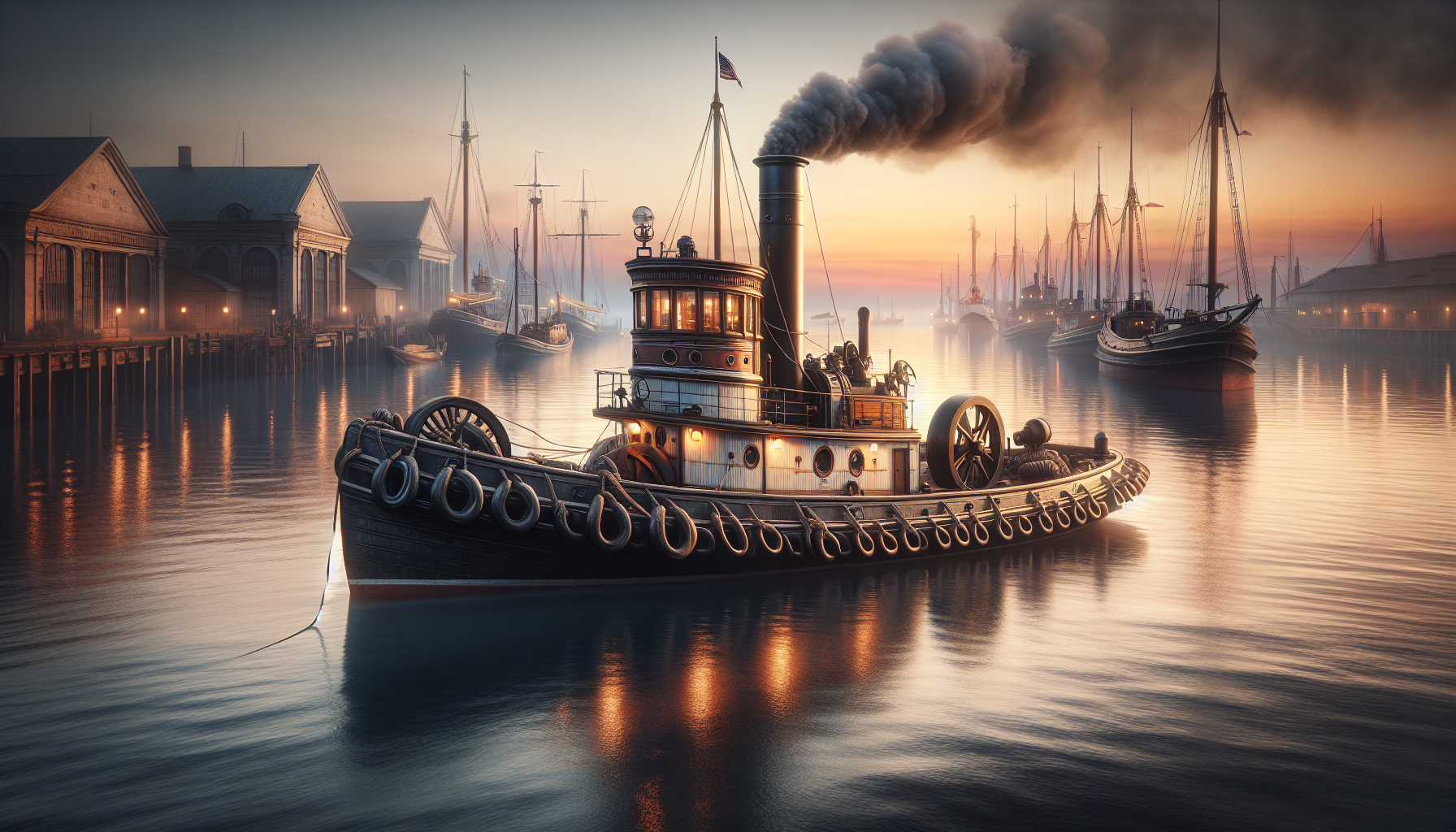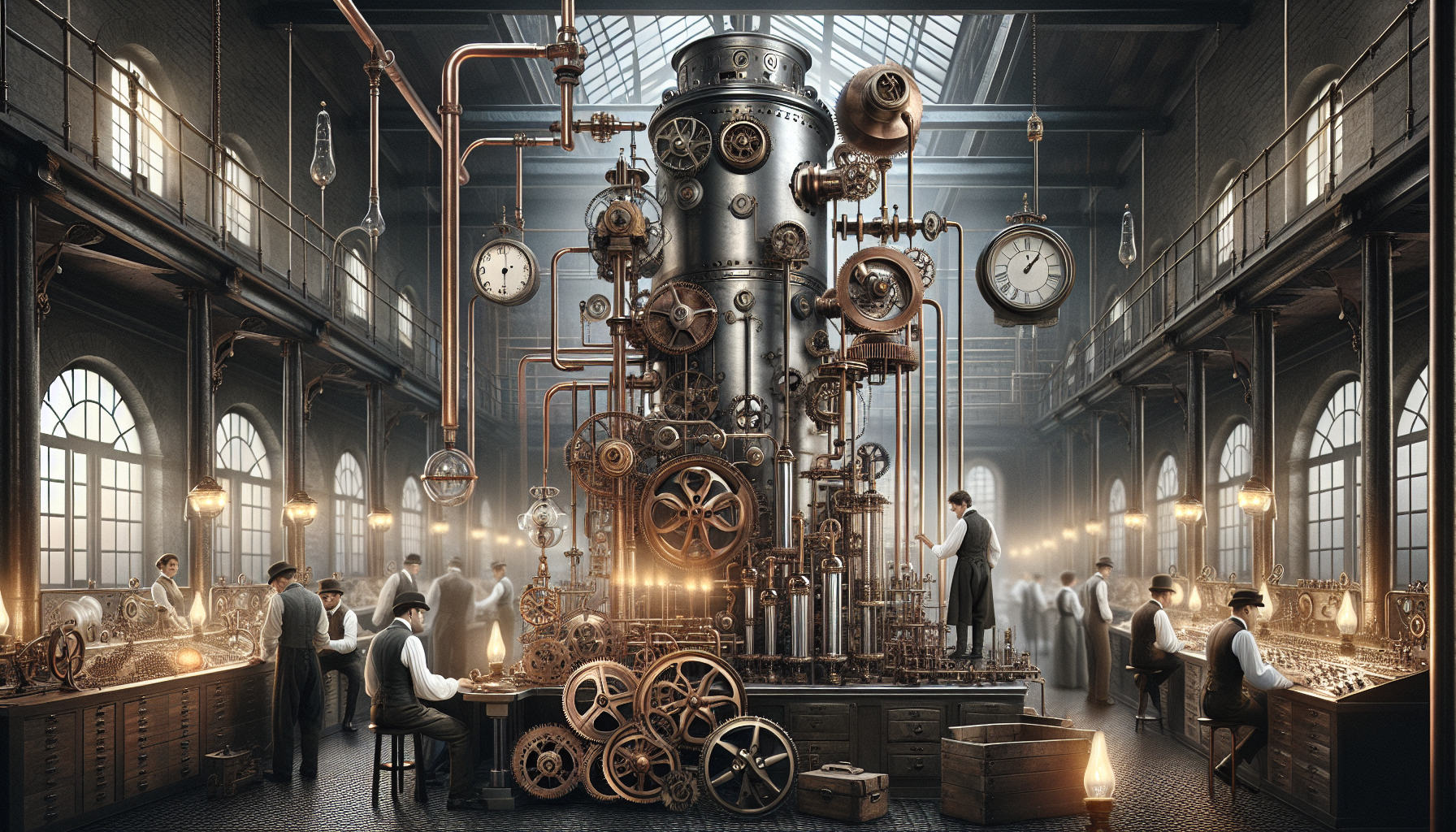In the vast expanse of maritime history, few vessels have captured the imagination quite like the steam tugboats. These unassuming yet powerful machines, once the stalwarts of bustling harbors and mighty rivers, hold stories as deep and rich as the waters they navigated. As we journey through the annals of time, we’ll uncover the legendary tales of these steam-powered titans, whose influence and legacy continue to echo in the corridors of maritime lore. From their humble beginnings in the early 19th century to their status as iconic symbols of industrial might, steam tugboats have played a pivotal role in shaping the narratives of trade, transportation, and technological innovation.
Imagine standing on the docks of a historic port, the air thick with anticipation and the scent of coal and saltwater. Before you lies a steam tugboat, its engine rumbling with the promise of raw power, ready to escort the grandest of ships through treacherous channels or rescue vessels in distress. These tugboats were not merely workhorses; they were lifelines, ensuring the safe passage of goods and people, and in doing so, they became revered figures in the world of seafaring. The romance of these vessels lies not only in their functionality but in the human stories that are intertwined with their existence. From the skilled hands that operated them to the ingenious minds that engineered their creation, steam tugboats are a testament to human ingenuity and resilience.
Throughout this article, we will dive into the origins of steam tugboats, exploring the technological breakthroughs that allowed these mighty vessels to revolutionize maritime operations. We will trace their evolution, examining how these boats adapted to the ever-changing demands of the industrial age and contributed to the economic expansion of nations. As we uncover the narratives of famous tugboats and the crews that manned them, you’ll be transported to pivotal moments in history where these vessels played crucial roles, whether in wartime efforts or peacetime endeavors.
Furthermore, we’ll look at the enduring legacy of steam tugboats and their transformation from indispensable tools of maritime commerce to cherished cultural icons. Their stories continue to inspire and captivate enthusiasts and historians alike, serving as a reminder of a bygone era when steam and steel ruled the waves. So, come aboard as we set sail on a voyage through time, unraveling the remarkable stories of steam tugboats and celebrating their place in the grand tapestry of maritime history. 🌊🚢✨
The Rise of Steam Tugboats: Engines of the Industrial Revolution
Steam tugboats emerged as formidable forces during the Industrial Revolution, revolutionizing maritime operations with their power and efficiency. These vessels, initially used to maneuver larger ships through narrow harbors and difficult waterways, quickly became indispensable to the global shipping industry. The industrial era was marked by rapid technological advancements, and steam tugboats were at the forefront of this maritime transformation. By harnessing the power of steam, these boats significantly increased the speed and reliability of towing operations, making them essential components of commercial and military fleets worldwide.
The development of steam engines allowed for greater control and maneuverability, which was crucial in the crowded and often treacherous ports of the 19th century. Unlike their sail-driven counterparts, steam tugboats were not reliant on wind conditions, allowing them to operate consistently in various weather conditions. This reliability made them an attractive choice for shipping companies looking to maximize efficiency and minimize delays. Moreover, the advent of steam power enabled tugboats to assist in the rescue of stranded ships, enhancing maritime safety and further solidifying their role in the shipping industry.
As industrialization expanded, so did the demand for raw materials and manufactured goods, leading to increased maritime traffic. Steam tugboats were instrumental in managing this surge, facilitating the smooth flow of goods and resources. They towed barges loaded with coal, timber, and other essential commodities, ensuring that the engines of industry remained fueled. This era also saw the introduction of standardized ship designs, which made tugboat operations more predictable and efficient. The table below illustrates some of the key differences between steam tugboats and their predecessors:
| Feature | Sail-Driven Tugboats | Steam Tugboats |
|---|---|---|
| Power Source | Wind | Steam Engine |
| Weather Dependency | High | Low |
| Speed and Efficiency | Variable | Consistent |
| Operational Range | Limited | Extended |
Check out this informative video on steam tugboats from the National Maritime Museum: Steam Tugboats: The Unsung Heroes of the Sea. 📽️ Watch and learn about the incredible engineering behind these powerful vessels!
Iconic Steam Tugboats: Pioneers and Innovators
Throughout history, several steam tugboats have achieved legendary status due to their remarkable feats and contributions to maritime history. These iconic vessels have become symbols of engineering prowess and are celebrated for their unique designs and accomplishments. Among them is the SS Great Eastern, an iron sailing steamship that, at the time of its launch in 1858, was the largest ship ever built. Designed by Isambard Kingdom Brunel, the Great Eastern was a marvel of engineering, equipped with the capability to lay the first successful transatlantic telegraph cable, a monumental achievement that revolutionized global communication.
Another renowned steam tugboat is the Hercules, which played a significant role in the development of the San Francisco Bay area. Built in 1907, the Hercules was instrumental in towing large vessels across the challenging currents of the Golden Gate Strait. Today, this historic tugboat is preserved as a museum ship, allowing visitors to experience firsthand the grandeur of early 20th-century maritime technology. Its robust construction and enduring legacy have made the Hercules an enduring symbol of the steam tugboat era.
Equally notable is the history of the Eppleton Hall, a paddlewheel steam tug built in 1914. The Eppleton Hall was one of the last paddle tugs constructed and was later restored and brought to the United States, where it is now part of the San Francisco Maritime National Historical Park. The vessel’s journey across the Atlantic and its subsequent preservation highlight the cultural and historical significance of steam tugboats, underscoring their enduring appeal and relevance. Below is a list of some iconic steam tugboats and their notable achievements:
- SS Great Eastern: Laid the first successful transatlantic telegraph cable.
- Hercules: Key player in the development of the San Francisco Bay area.
- Eppleton Hall: One of the last paddle tugs, preserved as a historical artifact.
- USS Mayflower: Served as a presidential yacht and played roles in both world wars.
The Evolution and Legacy of Steam Tugboats in Modern Times
As technology advanced, steam tugboats gradually gave way to more modern diesel-powered vessels. However, the legacy of steam tugboats continues to influence contemporary maritime practices and technology. The transition from steam to diesel engines marked a significant shift in the industry, leading to greater efficiency, reduced operational costs, and increased environmental consciousness. Despite their obsolescence in commercial operations, steam tugboats remain cherished relics of maritime history, with several preserved as museum ships and tourist attractions worldwide.
The preservation of these historic vessels serves as a testament to the ingenuity and resilience of early maritime engineering. By maintaining these ships, we honor the achievements of the past and educate future generations about the evolution of nautical technology. Steam tugboats also serve as a source of inspiration for modern engineers, reminding us of the importance of innovation and adaptation in overcoming challenges. The continued interest in steam tugboats is evident in the numerous festivals and events dedicated to showcasing these magnificent vessels, drawing enthusiasts and historians alike.
Moreover, steam tugboats have left an indelible mark on popular culture, appearing in literature, film, and art. Their iconic silhouettes and storied pasts evoke a sense of nostalgia and adventure, capturing the imagination of people around the world. As we look to the future, the stories and achievements of steam tugboats continue to inspire and remind us of the incredible feats that can be accomplished through human ingenuity and determination.

Conclusion
In wrapping up our exploration of the legendary tales of steam tugboat histories, it’s clear that these maritime powerhouses have left an indelible mark on the annals of naval engineering and history. From their inception as vital components of the industrial revolution to their status as iconic symbols of maritime heritage, steam tugboats have proven to be more than mere vessels; they are storied artifacts that encapsulate the progress and ingenuity of human endeavor.
We began our journey by tracing the roots of steam tugboats, highlighting their emergence in the early 19th century as indispensable tools for the burgeoning shipping industry. As vessels capable of maneuvering larger ships through tight harbors and treacherous waters, steam tugboats quickly became vital assets in global trade and commerce. Their robust design and powerful engines set a new standard for maritime engineering, paving the way for advancements that would shape the future of naval architecture.
As we delved deeper, we explored the various roles that steam tugboats played beyond their primary function of towing. Their versatility became evident as they served as salvage vessels, icebreakers, and even firefighting ships. This adaptability underscored their significance in maintaining maritime safety and efficiency, proving that their contributions extended far beyond mere towing tasks.
The narrative also highlighted some of the most famous steam tugboats and their exploits, painting vivid pictures of their daring rescues and pivotal roles in historic events. These stories not only serve as thrilling accounts of bravery and skill but also remind us of the human element behind these mechanical marvels. The crew members, often working under challenging conditions, demonstrated resilience and determination, qualities that are as integral to the tugboat legacy as the vessels themselves.
The evolution of steam tugboats also reflects broader technological and environmental shifts. As steam engines gradually gave way to diesel and electric power, the legacy of these steam-driven giants was preserved through dedicated restoration efforts and museum exhibits. Today, steam tugboats are cherished not only as historical artifacts but also as symbols of a bygone era of industrial might and maritime adventure.
The significance of steam tugboats is further underscored by their cultural impact. They have inspired art, literature, and film, becoming emblematic of a period where human innovation was propelled by steam. Their enduring presence in popular culture speaks to a collective nostalgia and admiration for the era they represent.
In recognizing the historical and cultural importance of steam tugboats, we must also acknowledge the ongoing efforts to preserve their legacy. Organizations and enthusiasts worldwide continue to restore and maintain these vessels, ensuring that future generations can appreciate their rich histories and the lessons they impart. The preservation of steam tugboats is not merely about maintaining old ships; it’s about celebrating human ingenuity and the spirit of exploration and adventure that they embody.
As we conclude this exploration, it is crucial to reflect on the broader implications of the steam tugboat legacy. These vessels teach us about the power of innovation and adaptability, values that remain relevant in today’s rapidly changing world. By studying their histories, we gain insights into the challenges and triumphs of the past, which can inform and inspire our approach to contemporary issues.
I encourage you, the reader, to delve deeper into the fascinating world of steam tugboats. Whether it’s visiting a maritime museum, engaging with online communities, or supporting preservation efforts, there are myriad ways to connect with this rich maritime heritage. Share your newfound knowledge and enthusiasm with others, and consider how the stories of these remarkable vessels resonate with your own experiences and aspirations.
Your engagement and curiosity are vital in keeping the legacy of steam tugboats alive. By participating in discussions, sharing your thoughts on social media, or even starting a local interest group, you can help foster a greater appreciation for these maritime icons. Let’s ensure that the tales of these legendary steam tugboats continue to inspire and educate for generations to come.
In closing, the story of steam tugboats is a testament to human creativity, resilience, and the relentless pursuit of progress. These vessels, once powerhouses of the sea, now stand as enduring symbols of our maritime heritage. As we celebrate their storied past, let us also look forward to the ways they can inspire future generations to chart their own courses with courage and ingenuity. 🌊
For further reading and exploration of steam tugboat histories, consider visiting reputable sources such as the Maritime Heritage Trust or exploring exhibits at the National Maritime Museum. These resources offer a wealth of information and insights into the fascinating world of steam tugboats and maritime history.
Toni Santos is a visual historian and creative artisan whose work channels the bold spirit of the steam-powered era—a time when imagination, mechanics, and ambition converged to reshape the modern world. Through richly detailed visual narratives and handcrafted design, Toni celebrates the legacy of steam innovation as both an artistic and technological revolution.
Driven by a passion for mechanical aesthetics, forgotten inventions, and industrial-age ingenuity, Toni reimagines the world of steam through illustrations, tactile artifacts, and storytelling that capture the poetry of pressure, motion, and invention. From piston-driven engines to brass-detailed diagrams, each piece reveals how steam wasn’t just power—it was promise.
With a background in visual design and historical research, Toni brings a craftsman’s eye and a dreamer’s heart to the stories of tinkerers, inventors, and visionaries who shaped the 19th century. His work doesn’t merely document machines—it honors the culture, courage, and creativity that drove a world to reimagine itself through gears, valves, and vapor.
As the creative voice behind Vizovex, Toni shares curated articles, reconstructed blueprints, and visual interpretations that bring this industrial past to life. His collections serve as a tribute to:
The elegance of steam-era design and innovation
The human stories behind great mechanical feats
The aesthetic beauty found in function and form
The echo of invention in today’s creative world
Whether you’re a history lover, a fan of steampunk, or an admirer of antique technology, Toni welcomes you into a world where art and machinery fuse, one cog, one drawing, one rediscovered marvel at a time.





